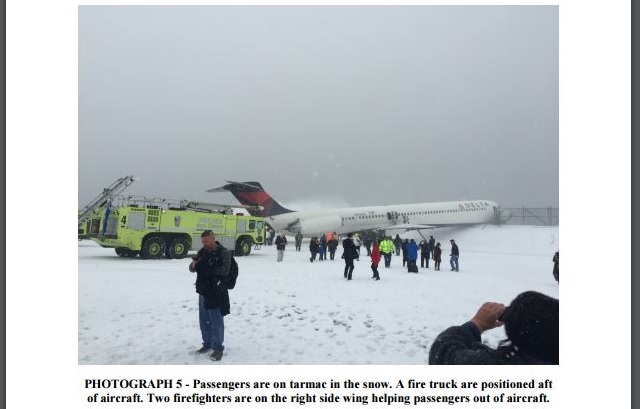The National Transportation Safety Board (NTSB) has reiterated a longstanding recommendation for better runway condition reporting -- a call that comes just weeks before new reporting standards are set to take effect.
In its report into the 2015 crash of Delta Air Lines flight 1086, the safety investigatory agency urges the Federal Aviation Administration (FAA) to support development of onboard systems that measure braking ability.
"This accident demonstrates the continuing need for objective, real-time, airplane-derived data about runway braking ability for flight crews preparing to land with runway surface conditions that are worse than bare and dry," the NTSB says in its 13 September report about the 2015 Delta accident.
"The NTSB continues to encourage the FAA to develop the technology for these systems because they are expected to provide objective, reliable, real-time information that flight crews of arriving airplanes could use to understand the extent of runway surface contamination," the NTSB writes.
The Delta aircraft, an MD-88, careened off LaGuardia's runway 13 while attempting to land during a snowstorm. It came to rest on a berm along the shore of Flushing Bay, causing minor injuries.
The report, released 13 September, pins the accident on pilot error, but says the snow-covered runway and "subjective nature" of braking action reports played a role.
The pilots chose to land after receiving reports of "good" braking from several other pilots. In fact, the NTSB concludes, braking action at the time of the accident was likely "medium".

NTSB.
The report notes that the NTSB made the same runway braking recommendations nine years ago in response to the December 2005 crash of Southwest Airlines flight 1248 at Chicago Midway International airport.
That aircraft, a 737-700, slid off the end of the runway and onto a road during a snowstorm, killing a child in an automobile.
Former NTSB board member John Goglia says safety investigators have known about runway reporting deficiencies for decades.
He cites the 1982 crash of a World Airways McDonnell Douglas DC-10 at Boston Logan International airport.
That aircraft slid off the end of the runway and into Boston Harbor after attempting to land on a snow- and ice-covered runway, killing two people, NTSB documents show.
The airport's failure to properly assess the runway condition and to transmit recent pilot braking reports to the DC-10 pilots contributed to the accident, the NTSB concluded.
"We [have] long had issues with what the ground crew was telling the captain," Goglia tells FlightGlobal. "There is a lot of work to be done."
NEW REPORTING STANDARDS
The NTSB's latest recommendations go far beyond new FAA-developed runway reporting standards set to take effect 1 October.
The new "takeoff and landing performance assessment standards" are aimed at helping pilots determine required stopping distance, thereby helping prevent accidents caused by runway contamination, the FAA has said.
Announced by the FAA in July, the standards apply to airport-provided runway reports, and do not replace pilot braking action reports.
The new system does away with "Mu numbers", which describe runway braking friction. Those numbers will be replaced by descriptions of conditions, such as whether a runway is covered in wet or dry snow, and how much, the FAA says.
The descriptions will also include codes, which correlate to expected aircraft performance and braking action, the agency said.
The Air Line Pilots Association, International (ALPA), has supported the standards, citing them in a response to the NTSB's report on the crash of Delta flight 1086.
"The… standards will help provide more information about runway conditions, which will help prevent runway excursions and enhance the safety of operations," writes ALPA. "The new guidance will provide pilots with improved data regarding runway conditions before they are able to see the runway."
Goglia sees room for further improvement, but says the new reports should improve safety.
"The FAA is trying to get better runway condition reporting," he says. "It does appear it's going to add additional information that can help the crew."
Source: Cirium Dashboard


























